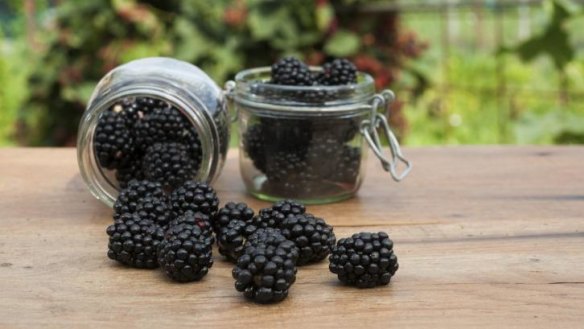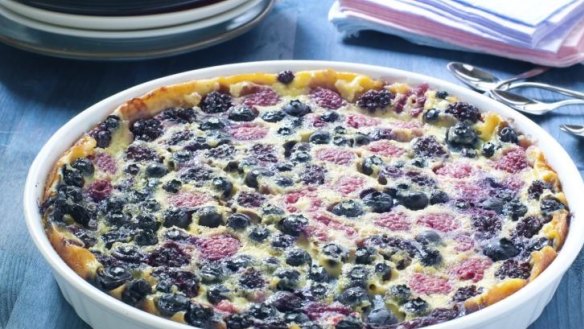Owen Pidgeon: How to grow mulberries in the ACT

One of the delights of summer is to stand under the big leaves of the mulberry tree and search for the fully ripe, black mulberries. When fully ripe, the fruit will fall off easily. If you happen to select a semi ripe one, then there will be a struggle with the stem staying firmly attached to the branch and the juice of the fruit will erupt and stain your hands so quickly.
The trees are magnificent with their spreading branches and big leaves. They belong to the same family as figs but produce the clusters of berry-like fruit in the axils of their leaves. The trees can grow several metres high and there is little pruning to be done. If you need to prune, then follow the approach to pruning apple trees leaving either a central leader or create a vase-shaped form.
The mulberry tree originated in western Asia but was well known in the lands of the Mediterranean during the days of the Greek Empire. The Roman legions took cuttings and spread the mulberry tree across all of the Roman Empire. The two good specimens available today have an English heritage: the Black English and the Hick's Fancy.

Black mulberry varieties are much sweeter than the white mulberries and they thrive in cool climate locations. Mulberries need a high winter chilling to help with setting of the next season's fruit. White mulberry trees are usually grown to produce supplies of leaves for silkworms. There are cultivars of white mulberry trees from India and China, showing how widespread they became over the centuries.
If your tree is planted in a sheltered location, then the leaves will appear earlier than those on exposed trees.
Growing a mulberry tree gives you very few problems. The flowering times are late so they are not really affected by frosts. The tree is hardy and there are no real pests or diseases with the fruit itself – apart from the attraction that the ripening fruit has to passing birds. However, we do not have to net our mulberry trees.
And you can enjoy a much longer harvest from just one tree than with many other soft fruits. Some of the berries will be ripe close to Christmas and some will still be ripening in late January. This is aligned with the long period of flowering, as the male and female flowers are produced in separate long catkins and as the wind blows, the pollen is disbursed.
The ripe berries are similar to loganberries in size and shape – both being quite delicate to the touch, near black in appearance and really sweet. At times the fruit will drop just as they are becoming fully ripe. Sicilian growers lay down straw under their trees to softly catch the falling berries. But the under-ripe mulberry is only good for jam making – though with its high pectin content it is a winner.
Mulberries are good for jam making and just eating fresh, in a plate served with cream or ice-cream. If you can source some ripe, unbruised mulberries then a mixed berry clafouti is just the thing to serve up to guests in mid summer.
Summer berry clafoutis
300g black mulberries
200g blackberries
125g raspberries
125g blueberries
3 free-range eggs
80g castor sugar
1 tsp vanilla essence
50g plain flour
1 tbs self-raising flour
170ml skim milk
Grease four dessert shallow ovenproof dishes and place on an oven tray. Gently mix the berries in a bowl and carefully ladle them into the four dishes.
Whisk the eggs well and add in the caster sugar and vanilla essence. Add in the flours and milk and mix further until combined well. Pour gently the mixture over the berries, using the back of a tablespoon to break the pouring. Bake at 170°C for 30-35 minutes until the clafoutis are set. Sprinkle with icing sugar and serve while still warm.
This week in the garden
* Plant out some rows of bush beans and keep planting a selection of loose-leaf lettuces. Plant radishes and rocket, kale and silverbeet.
* January is also the time to plant seeds of the winter vegetables, such as cabbage, broccoli and cauliflower. This will give the new plants time to become well established before cold days set in.
* You can 'bandicoot' your potato patch now to carefully remove a few large tubers from the sides of the hilled up rows, for family use. Leave the plants in situ to grow on a produce a bigger crop in time.
* Keep spreading mulch around your garden beds. It is amazing how much more moisture will be retained and how much cooler the soil will be with a good protection layer of sugar cane, pea straw or lucerne mulch.
* Water all of your plants with a seaweed or worm based foliar spray and then water in well, to boost the cells of the plants and aid the production of fruit.
* Give your large leaf plants and sweet corn a supplement of compost around the root lines as they are heavy feeders and so will enjoy this extra care.
Owen Pidgeon runs the Loriendale Organic Orchard near Hall.
Restaurant reviews, news and the hottest openings served to your inbox.
Sign up